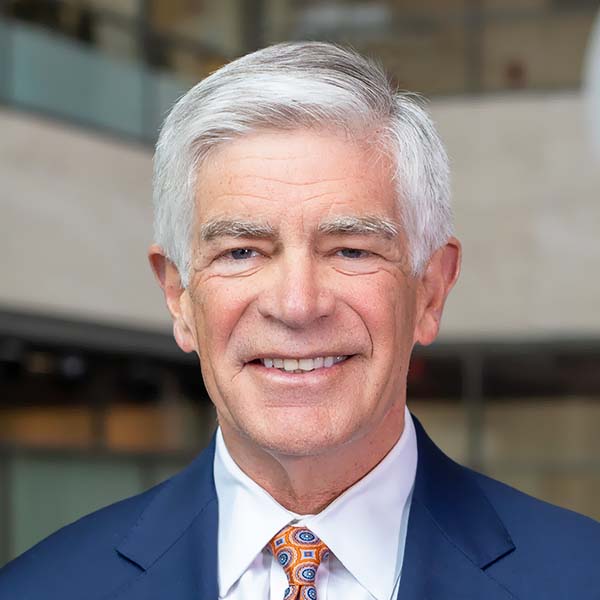Good afternoon, everyone, and welcome to the Philadelphia Fed.
Thank you, Susie Kendis, for that introduction and to you and your colleagues at Deloitte for yesterday’s conference, which laid significant groundwork for these next two days of discussions.
I also thank our friends at Working Nation, the City of Philadelphia, and Drexel University’s Lindy Institute for helping us put together this series of events.
Now, a quick reminder of the usual Fed disclaimer: The views I express today are my own and do not necessarily reflect those of anyone else on the Federal Open Market Committee (FOMC) or in the Federal Reserve System.
This is an exciting event for me as it gives me the opportunity to highlight some of the truly groundbreaking research going on under this roof. It may be easy to think of the Federal Reserve only in terms of monetary policy and interest rates and such — and I honestly can’t blame you — but the work we do here every day is varied, dynamic, and truly impactful as you will see.
As you may know, for nearly 50 years, the Federal Reserve has worked according to the dual mandate that Congress handed down to us. One pillar of this dual mandate is price stability. That’s the one you read about most in the news as we continue our efforts to wrestle inflation back down to our 2 percent annual target. And as an aside, we are making steady progress, but more remains to be done.
The other — equally important, if somewhat less reported — is to promote maximum employment. But what does that mean, maximum employment? Well, I look at it as a two-way proposition. It’s not just promoting economic conditions through which employers can open their doors for workers to come in. Job growth is important, but it’s not the end-all, be-all.
For me, maximum employment also means promoting a climate in which workers in those jobs are treated with respect and dignity, and where work isn’t just something to be rewarded but something that is truly rewarding. Put another way, while the quantity of available jobs is important, so, too, is the quality of those jobs.
So, it is upon the pillar of maximum employment in which we find the Worker Voices Project.
Yesterday, I published an article on the Philadelphia Fed’s website with my perspective on some of what the Worker Voices Project tells us. If you have not yet done so, I do encourage you to read it — just maybe not at this very moment. But allow me to give you a couple of spoilers.
I opened my article with a direct quote from one of the many workers interviewed through the Worker Voices Project, who said, “I know that I can bring a lot to the table. Are you going to uphold your end of the half as an employer?”
And I closed the article by writing the following: “I am proud that our research is being put into action toward innovations that can meet the needs of our workforce while forging the strong economy of tomorrow. And this research is not just going to benefit us as economists but, ultimately, more so as a society.”
This brings me to this event today and the further discussions that will take place tomorrow.
As economists, we have many tools and models through which we can study the forces that exert their push and pull on the labor market and those participating in it. Make no mistake, these hard data are important. Hard data give us — pun fully intended — concrete points, which, through time, we can identify employment trends, identify precursors of labor force realignments, and support potential changes in public policy.
From what I said a moment ago, the hard data tell us a lot about the quantity of jobs.
But even for all its strengths and directional guidance, the hard data cannot tell us what is going on at the most micro level — the decisions individual workers are making about their own futures. These soft data, the data reported through the Worker Voices Project, are a critically important supplement to the hard data. Actually, strike that, it’s not a supplement; it’s a full-fledged partner. We need to look at both, equally.
And when looking at the Worker Voices Project, I see the means for us to coalesce around basic principles that classic economics cannot capture in a model or on a chart. This is what comes to my mind when I hear the phrase “research in action.”
If you don’t know, even though I sit as president and CEO of the Philadelphia Fed, economics wasn’t my first pursuit. By education, I’m an engineer. And if you know one thing about engineers, we cannot just let things be, when we know, deep down, systems can be made more efficient, more effective, and even more fair.
There’s nothing that an engineer enjoys more than lifting the cover and looking at what’s going on underneath. And there’s nothing that an engineer enjoys less than hearing that something can’t be changed because “that’s just the way we do things.”
And this is what we’re doing here — we’re lifting the cover to see how we can make the labor market work more efficiently, effectively, and fairly for workers. And, over the course of the next two days, we’re not going to allow ourselves to be limited by the old ways of thinking.
That’s not being anti-employer. Far from it. As I have traveled across the Third District and talked with employers, I hear directly how hard they’re working to find the employees their businesses need to be successful — and once these employees are in, they don’t want to lose them.
Yet, many of these employers are sticking only to the means through which they’ve attracted workers in the past — namely, higher wages and more benefits. And not surprisingly, they are finding these tools alone aren’t as effective as they once were.
The Worker Voices Project, and the discussions and actionable research stemming from it, is a means through which we can provide these employers new and better tools to attract and retain workers. These are the workers who can see their values reflected in those held by their employer and their value rewarded not just in terms of wages but in terms of being treated with dignity.
Now, I could go on as my excitement for and belief in this transformational research is nearly inexhaustible — unlike attention spans. And every minute I give back is a minute we can spend hearing from the subject experts, who are doing the research, and those living it.
So, with that, I will yield the microphone. But, again, thank you all for coming this afternoon. I hope both the rest of today’s forum and tomorrow’s working session are, like a good job, equally productive and rewarding.
- The views expressed here are solely those of the author and do not necessarily reflect the views of the Federal Reserve Bank of Philadelphia or the Federal Reserve System.

